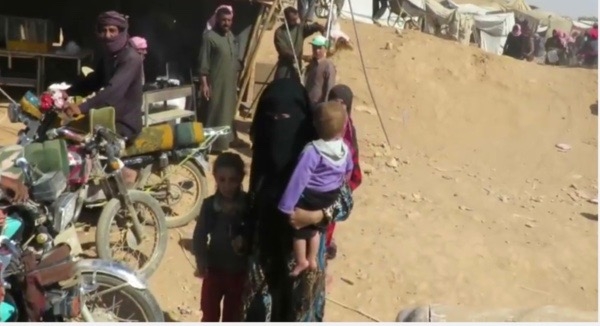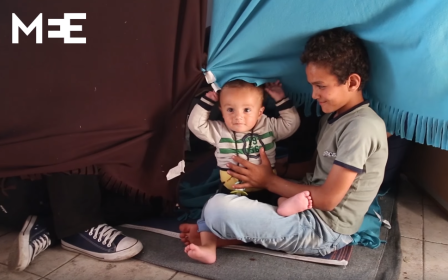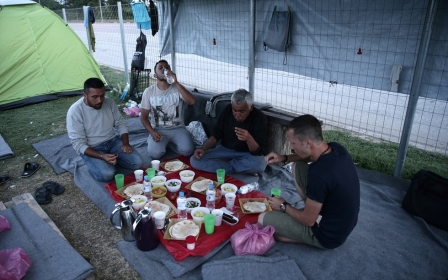REVEALED: Ruqban - the unknown refugee camp at Jordan's border

AMMAN – Nearly as far as the eye can see, there are tents blending into open desert.
Children in tattered clothing haul empty water containers. Roads buzz with foot traffic, as motorcycles weave by ad-hoc shops selling dry goods and fruits and vegetables, and even a pharmacy.
Little has ever been seen of life inside Ruqban, a remote desert crossing-point where displaced Syrians are bottlenecked against the closely guarded Jordanian border.
Legal and security constraints prevent the Jordanian military and aid agencies from entering the inaccessible demilitarised zone. And while satellite images have given hints, showing a growing sprawl of tents and a network of roads criss-crossing the settlement, no journalist has gone into Ruqban.
But now the first video has emerged showing everyday life in the camp where more than 60,000 people are caught in limbo between war and refuge.
The footage, uploaded to YouTube by a Free Syrian Army affiliate operating at the remote desert crossing-point of Ruqban, purports to show what life is like inside the settlement.
Younes Salama, spokesman of the FSA group the Lions of the East, told MEE he shot the footage from the trucks and motorcycles the faction uses to patrol the sprawling area.
The seven-minute video provides compelling evidence that the ad-hoc encampment is no temporary outpost, but an entrenched settlement growing more permanent by the day
The camp’s development poses major concerns for Jordanian authorities who say they fear Islamic State militants are among displaced Syrians amassing at its border, and for aid workers who say conditions there fail to meet internationally recognised standards – yet both seem powerless to stop its growth.
The road to Ruqban
In the early days of the Syrian conflict, refugees poured into Jordan. On the western stretch of the border between the two countries, hundreds of thousands of people came south from Daraa province, a flow that peaked in summer 2012 at several thousand arrivals per night.
By late 2013, overwhelmed, Jordanian authorities decided all crossing-points with Syria would be closed to refugees except for two in the far eastern desert: Ruqban, near the point where Jordan, Syria and Iraq converge, and Hadalat, 80km to the west.
Both points are, quite literally, in the middle of nowhere. Only Bedouins inhabit the eastern desert; there are no permanent settlements. Rocky and wind-battered, it is blisteringly hot in summer and drops below freezing in winter. There are no water sources or natural defences.
Despite this, by early 2014, Ruqban was the main stopping point on one of the last roads out of Syria.
Refugees who made the journey say they paid smugglers to take them south on the Ruwaishid road - named for a small Jordanian town 160km south of the border – to the demilitarised strip that runs between Syria and Jordan.
They climbed over an earthen berm separating Syria from the demilitarised zone and walked five or so kilometres south, to a second berm at the northern edge of Jordan. There they waited to be let in.
A world out of reach
Although the Jordanians let in a build-up of Syrians in late 2014 after a flurry of critical media coverage, a backlog of around 12,000 people had settled at Ruqban before Russian air strikes launched in October and triggered a new swell of displaced Syrians.
Now there were new complications: more people on the berm were fleeing IS-held areas and, according to the Jordanian government, this raised red flags.
In February, King Abdullah said there were IS “elements” among refugees, which was dragging out the vetting process to admit people to Jordan.
As the size of the group has grown, so have suspicions.
“Why come here all the way from Raqqa? They had no convincing answer and they moved almost 600km in the desert to reach us,” Jordanian government spokesman Mohammad Momani told MEE.
While some humanitarians disagreed, no one really knew because Ruqban was still out of reach behind the berm.
It was also growing fast. According to refugees and aid workers, the population surged a second time after the cessation of hostilities that began on 27 February. People felt it was safer to travel – so they travelled south, to Ruqban.
Around this time, Ruqban shifted from an ad-hoc settlement – displaced Syrians, the smugglers who ferried them south, a few traders and Bedouins – to something aid workers, government officials and the refugees themselves agree is increasingly complex and harder to control.
Pushed by war, pulled by a variety of factors
According to internal UNHCR documents seen by MEE, around half of the people at Ruqban have approached UN staff at the berm to register as refugees.
But many of the other 25,000 or so people are there for reasons other than wanting to enter Jordan, including its relative security compared to the rest of Syria.
“The berm is a border, so there are no air strikes. It’s safer, that’s the most important thing,” a nursing mother named Zeina told MEE at Azraq refugee camp, opened in April 2014 about 100km east of the capital Amman.
Zeina and her extended family spent four months at Ruqban over the winter and said that, while she and her family had wanted to come to Jordan, many of the people they met were there for safety reasons, and had no intention of entering Jordan.
The availability of aid is also a draw. While UN-registered refugees get more comprehensive aid, everyone gets bread and water: the International Organization for Migration hands out 150,000 pieces of bread each day and UNICEF runs a fleet of daily water trucks. The fact that staff and supplies must be driven to the border daily over rough desert tracks in four-wheel drive vehicles – a five-hour round-trip from Ruwayshid, the nearest town – adds a huge cost to all aid distributed at the border.
“In the desert, there’s no clean water and very little food. Of course, life on the berm is better,” teenaged Ismael told MEE from his shelter at Azraq.
He, his younger brother and his mother, from Palmyra, were drawn to Ruqban not in hopes of reaching Jordan, but by the promise of bread and water.
There are also profiteers. There is money to be made selling and trading food and supplies to people marooned for months at a time. The video shows the scale of the Ruqban’s black-market economy – an economy many refugees call exploitative.
“When you arrive [at the berm], you have nothing but the clothes on your back, maybe a small bag. You can buy anything there, but it is really, really expensive,” said Aamer Hussein, a young father from Palmyra. He and his wife spent four months on the berm, reaching Azraq in April.
As Ruqban’s population swelled earlier this year, rioting and inter-tribal violence spiked. New arrivals at Azraq described certain tribes ganging up on others and controlling access to water. Aid distributions were cut short due to rioting, and according to aid workers present at the time, at least one person was shot during clashes with border guards.
Humanitarians warned that where there was war profiteering and banditry, there was also trafficking, but the lack of access made it hard to prove anything.
Then, in late April, there was a new presence at Ruqban: the Lions of the East. The rebel group, a new affiliate to the Western and Jordan-backed Southern Front coalition, gets its pick-up trucks, weapons and ammunition through the Amman-based military operations centre (MOC) that supplies many southern FSA groups. The group claims to have been trained by American instructors in Jordan in a secretive 20-day CIA-run programme covering basic infantry skills. The CIA wouldn’t comment on the programme.
According to spokesman Younes Salama, who filmed the Ruqban video, around 50 men at a time come to the berm for shifts lasting about a week.
“Our duties are to patrol outside the camp to protect it and to patrol inside the camp to ensure security,” Salama told Middle East Eye.
But with the majority of the group coming from a region and tribes that are common to some but not all of Ruqban’s inhabitants, there have been reports by both aid workers and refugees that some inter-tribal rivalries have been stoked by the group’s presence.
Ruqban: Here to stay
While Salama maintains that there is no coordination between Jordan and his group on their work in the camp, government insiders speak of extensive “human surveillance” in the settlement. Jordan’s border guards also have a history of collaborating with FSA groups, particularly those funded by the MOC and armed though Jordan, to keep borders secure.
The Lions of the East also support the New Syrian Forces, a Pentagon-funded group of Syrian rebels based several kilometres from Ruqban, who are trained and backed by Jordanian, American and British special forces based 2km south of the settlement, at the military base that gives Ruqban its name.
As unlikely as it is that the group is operating in isolation, it is equally unlikely that the longer-term goals Salama describes have not been approved on this side of the border.
“We have sent a team to build a school for children who lost their future between these worn out tents, and to build a field hospital inside the camp,” said Salama.
These changes, coupled with the improved services area under construction near the berm, point to an acceptance that Ruqban has passed a point of no return: its growth can no longer be stopped, just shaped. And Jordan, desperate to limit the number of new refugees arriving, stands to gain by making this temporary settlement a more permanent camp.
Government spokesman Momani said the country was admitting around 200 refugees per day – something that, along with the increasingly camp-like facilities offered, is likely drawing displaced Syrians to Ruqban, compounding the problem.
“Jordan does not need to present its credentials when it comes to hosting refugees. We are willing to move the refugees to any country that might be willing to take them. We’ll even use our own airplanes,” Momani told MEE.
Until such an offer materialises, Jordan, humanitarian agencies and the growing number of people marooned in the desert are stuck in a situation with no clear solution.
Aid bosses say they feel devastated about Ruqban. Conditions are appalling. Internationally recognised minimum standards – for safety, the provision of food, water and healthcare – are not being met. Above all, they are unable to offer protection – that very basic principle of humanitarian aid.
And yet, for the few agencies granted access, if taking part feels like supporting a policy they cannot stomach, not taking part would be much worse.
“It’s becoming a de-facto safe zone, using the civilian population as a buffer,” said a senior humanitarian with a major international charity, speaking anonymously to avoid angering authorities and potentially endangering her agency’s access to Ruqban,
“It’s not acceptable that we are there, but it’s unacceptable for us not to be.”
Middle East Eye propose une couverture et une analyse indépendantes et incomparables du Moyen-Orient, de l’Afrique du Nord et d’autres régions du monde. Pour en savoir plus sur la reprise de ce contenu et les frais qui s’appliquent, veuillez remplir ce formulaire [en anglais]. Pour en savoir plus sur MEE, cliquez ici [en anglais].




